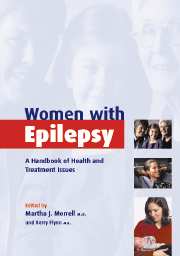Book contents
- Frontmatter
- Contents
- List of contributors
- Part I The woman with epilepsy
- Part II Epilepsy diagnosis and treatment
- 5 The genetics of epilepsy
- 6 Epilepsy: epidemiology, definitions, and diagnostic procedures
- 7 Antiepileptic drugs and other treatments for epilepsy
- 8 Epilepsy in children and adolescents
- 9 Nonepileptic seizures
- Part III Hormones and the brain
- Part IV Health challenges for women with epilepsy
- Part V Family planning, pregnancy, and parenting
- Part VI Living well with epilepsy
- Appendix: The Epilepsy Foundation's Campaign for Women's Health: bringing help and hope to women with epilepsy
- Index
- References
7 - Antiepileptic drugs and other treatments for epilepsy
from Part II - Epilepsy diagnosis and treatment
Published online by Cambridge University Press: 02 November 2009
- Frontmatter
- Contents
- List of contributors
- Part I The woman with epilepsy
- Part II Epilepsy diagnosis and treatment
- 5 The genetics of epilepsy
- 6 Epilepsy: epidemiology, definitions, and diagnostic procedures
- 7 Antiepileptic drugs and other treatments for epilepsy
- 8 Epilepsy in children and adolescents
- 9 Nonepileptic seizures
- Part III Hormones and the brain
- Part IV Health challenges for women with epilepsy
- Part V Family planning, pregnancy, and parenting
- Part VI Living well with epilepsy
- Appendix: The Epilepsy Foundation's Campaign for Women's Health: bringing help and hope to women with epilepsy
- Index
- References
Summary
The mainstay of epilepsy treatment is medication. Fortunately, because of a great deal of research in antiepileptic therapy, we now have twice as many antiepileptic drugs available as we did 10 years ago. This is exciting news for people with epilepsy and for their health-care providers. However, it means that antiepileptic drug choice is more complicated. The health-care provider considers seizure type, possible side effects, dosing schedule, safety, and cost in selecting a medication for each individual.
Dr Jacqueline French is an Associate Professor of Neurology at the University of Pennsylvania. She has been involved in the trials leading to the release of all of the new antiepileptic medications, and writes about this topic as well as lecturing to neurologists all over the world.
This chapter provides a comprehensive and comprehensible review of the major antiepileptic drugs, which will be of interest to anyone taking this type of medication. More information about antiepileptic drugs can be found on the Epilepsy Foundation's website at www.epilepsyfoundation.org.
MJMOnce epilepsy is diagnosed, the next step is to decide whether treatment is indicated and, if it is, the best treatment choice. The decision to start medication implies that the benefits to be gained (eliminating or reducing seizure activity) outweigh the potential risks (side effects) and inconvenience. By deciding to take medication, a patient enters into a partnership with her physician.
Keywords
- Type
- Chapter
- Information
- Women with EpilepsyA Handbook of Health and Treatment Issues, pp. 68 - 76Publisher: Cambridge University PressPrint publication year: 2003



